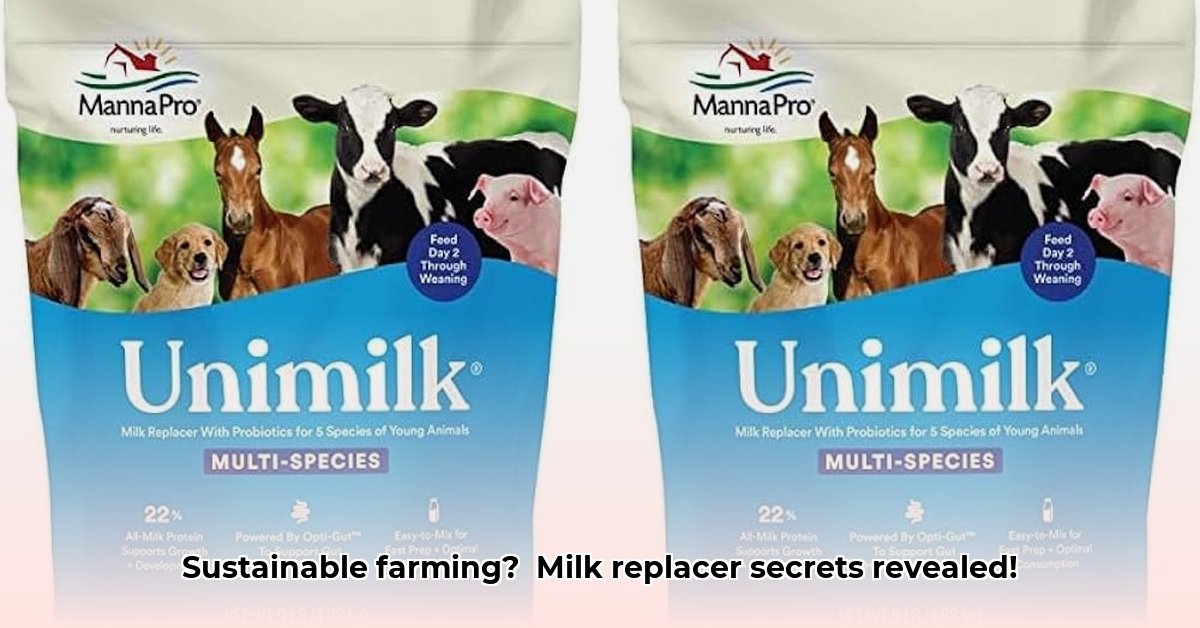
Choosing a Sustainable Milk Replacer: A Practical Guide
Raising healthy calves is paramount to a thriving dairy operation. Selecting the right milk replacer is crucial, and increasingly, farmers are prioritizing sustainable options. This guide provides actionable steps to help you choose, use, and source environmentally friendly milk replacers from Tractor Supply, boosting both your farm's profitability and its environmental footprint. For more information on sustainable milk replacers from Tractor Supply, check out this helpful resource: Tractor Supply Milk Replacers.
Understanding the "Sustainable" Label
What constitutes a truly "sustainable" milk replacer? It's not just marketing jargon; it involves a holistic approach to minimize environmental impact throughout the product's lifecycle. This encompasses:
- Ingredient Sourcing: Look for milk replacers using sustainably grown ingredients – crops cultivated with reduced reliance on synthetic fertilizers and pesticides. Consider locally sourced options to further minimize transportation emissions.
- Manufacturing Practices: Efficient production processes are key. This means lower energy consumption, reduced water usage, and minimal waste generation during manufacturing. Look for brands that are transparent about their manufacturing methods.
- Packaging: Sustainable packaging is critical. Choose products using recyclable or biodegradable materials to minimize waste ending up in landfills.
Selecting the Right Milk Replacer at Tractor Supply
Tractor Supply offers a variety of milk replacers. Here's how to make an informed choice:
Nutritional Needs: Prioritize a formula meeting your calves' specific nutritional needs at each growth stage. A well-nourished calf is healthier and more productive. Check the label for guaranteed analysis and protein percentages.
Ingredient Transparency: Scrutinize the ingredient list. Understand what's in the milk replacer and how it was sourced. Non-GMO and organic certifications can help build trust.
Cost-Effectiveness: Compare prices per pound and consider your calves' daily needs. While sustainable options may have slightly higher upfront costs, long-term benefits – healthier calves and reduced environmental impact – often outweigh this.
Ease of Use: Opt for a milk replacer that's easy to mix and feed. Clear instructions save time and effort.
Sustainable Practices Beyond Milk Replacers
Choosing a sustainable milk replacer is a significant step, but it's only part of a larger, holistic approach to sustainable dairy farming. Other impactful strategies include:
- Manure Management: Implement efficient manure management techniques such as composting or anaerobic digestion to reduce greenhouse gas emissions and nutrient runoff.
- Water Conservation: Utilize water-wise irrigation methods like drip irrigation or rainwater harvesting systems to minimize water usage.
- Pasture Management: Employ rotational grazing techniques to improve pasture health, reduce soil erosion, and provide optimal grazing for your animals.
A Step-by-Step Transition to Sustainable Milk Replacers
Switching to sustainable practices requires a thoughtful approach:
- Research and Compare: Thoroughly research different sustainable milk replacers at Tractor Supply. Compare ingredient lists, prices, and nutritional profiles. Utilize online resources and consult with agricultural experts.
- Pilot Program: Start with a small trial run, testing the new milk replacer with a smaller group of calves to monitor its effects before committing to a complete farm-wide change.
- Monitor and Adapt: Closely track your calves' health, growth, and milk yield. Adjusting feeding strategies as needed will ensure optimal results. Data-driven adjustments are crucial for improvement.
- Communicate: Consider sharing your findings with other farmers and agricultural professionals, promoting the adoption of sustainable practices within the community.
The Long-Term Benefits: Environmental and Economic
"The shift towards sustainable milk replacers is not simply an environmental imperative, it's a sound business decision," says Dr. Emily Carter, Professor of Dairy Science at the University of Wisconsin-Madison. "Reduced waste, healthier animals, and alignment with consumer preferences contribute significantly to long-term profitability."
Choosing sustainable milk replacers offers a multitude of benefits:
- Reduced environmental impact: Lower greenhouse gas emissions, reduced water pollution, and decreased land degradation. This aligns with global efforts towards sustainable agriculture.
- Improved calf health: Higher quality ingredients can contribute to healthier, more productive animals, thereby maximizing productivity.
- Enhanced brand image and consumer appeal: Consumers are increasingly aware of and value sustainable agriculture. This contributes to positive brand recognition and market differentiation.
- Long-term cost savings: While initial costs may be slightly higher, the long-term cost savings achieved through reduced waste, healthier animals and improved yield outweigh those costs.
Don't delay your transition to sustainable dairy farming. Visit Tractor Supply today and start building a more sustainable and profitable future for your farm.